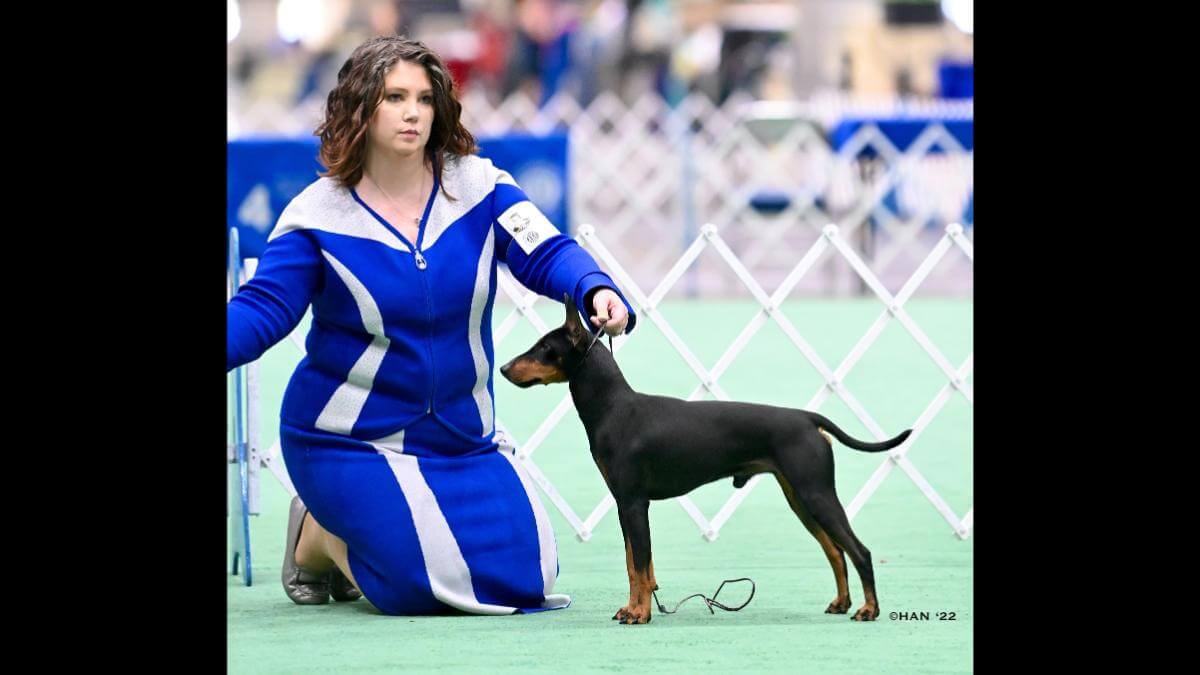
Home » Rachel Jonas | Mosaic Manchesters

Rachel Jonas
1. I am Rachel Jonas. David and I, and our two boys, are the heart of Mosaic Manchesters. Our journey with dogs began over 20 years ago when I started Obedience classes with a German Shepherd Dog I’d found at the shelter while David was deployed. It was there that I met and fell in love with a Toy Manchester Terrier, sparking our deep-rooted passion for the breed. We bred our first litter 10 years ago after a decade of involvement in the breed, a testament to our unwavering dedication to the breed. David chose our kennel name, Mosaic, after a friend suggested we use an alliteration of Manchester. This name now symbolizes our commitment to this wonderful breed.
2. Several hallmarks make Manchesters unique. The topline, reminiscent of the Whippet’s addition to the development of the breed, gave the Manchester not only the ability to course small game but also its distinctive silhouette. The Manchester strikes a delicate balance between sleek elegance and sturdy athleticism. For Manchester breeders, this balance is crucial, as straying too far in either direction would compromise what makes the Manchester unique.
3. There are always more people who want Manchesters than there are Manchesters available. The biggest issue Manchesters faces is that the breed remains largely unknown. Social media has helped them become more visible, but it is still an uphill battle.
4. As the Public Education Chairperson for the American Manchester Terrier Club and as a breeder, I try to ensure that both the Manchester and myself personally have a presence on all the large social media platforms. One of the podcasts I listen to (Pure Dog Talk) had an excellent episode with the Dandie Dinmont community, and they spoke about how important it was to remove obstacles between the pet-buying public and breeders. I strive to meet pet buyers where they are, helping them learn more about the breed and connect them with breeders if I don’t have puppies available. Regarding the benefits of science to our breeding program, we are fortunate that the Manchester is a generally healthy breed. Still, we laud our Health Chair for her diligence and tirelessness in staying on top of any upcoming health concerns.
5. There has been a shift in the public’s perception of purebred dogs. I believe the communications on social media platforms like TikTok and YouTube have helped the public see through the rhetoric of the animal rights propaganda that all purebred dogs are unhealthy, unloved, and miserable. And instead, they’ve allowed the public to see that they are just like every other dog, not at all what specific organizations would have them believe.
6. I love the trends towards protecting our Juniors, being more inclusive, and sharing knowledge. These initiatives will collectively help our sport build a better future. The concern I see as most troubling is the need to find red flags when nothing is black and white. The need for younger or less experienced people who have not yet had the time to learn the nuances of a breed only to paint the world in monochromatic swaths is further divisive in a sport that needs to find our commonality rather than drive a wedge in our already weather-worn community.
7. The televising of a variety of shows and dog sports has been incredibly beneficial in bringing new people into our sport and our breed.
The amazing podcasters, like Laura Reeves, the people who take the time to run and moderate groups, and those who livestream at shows have each played a huge part.
Add to that the people who run sites like Doggit.app, along with the folks posting on video platforms such as YouTube and TikTok. They’ve all pulled back the curtain on our world in ways that have allowed more people to join us—or simply made them feel more welcome to do so. Speaking from experience, it’s not an easy task to undertake. I think our community owes them all a massive collective “thank you.”